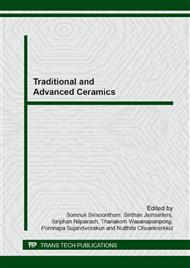p.230
p.235
p.241
p.247
p.253
p.259
p.264
p.274
p.280
Influence of the Laminate Configurations of Transparent Armor on its Ballistic Protection
Abstract:
The ballistic performance of transparent armors has been continuously developed for an application on security purposes. Generally, ballistic performance of the laminated glass increases with its thickness and weight while the user requirement prefers high level of ballistic protection with thin and light weight body. In this study, fabrication of light weight glass-PVB transparent armors with the level-3 protection according to the National Institute of Justice (NIJ) standard was attempted. The ballistic performances of various configurations of glass-PVB laminates were determined against 7.62 mm ammunitions. Results from fragmentation analysis indicated the influence of glass-sheet-arrangement in the armor structures on the ballistic damages. The minimum requirement on the thickness of front-face layer was also discussed. To verify the experimental results, finite element analysis was performed on all laminated systems. It was found that the results from computational analysis were in reasonable agreement with the experimental results.
Info:
Periodical:
Pages:
253-258
Citation:
Online since:
April 2014
Price:
Сopyright:
© 2014 Trans Tech Publications Ltd. All Rights Reserved
Share:
Citation:


